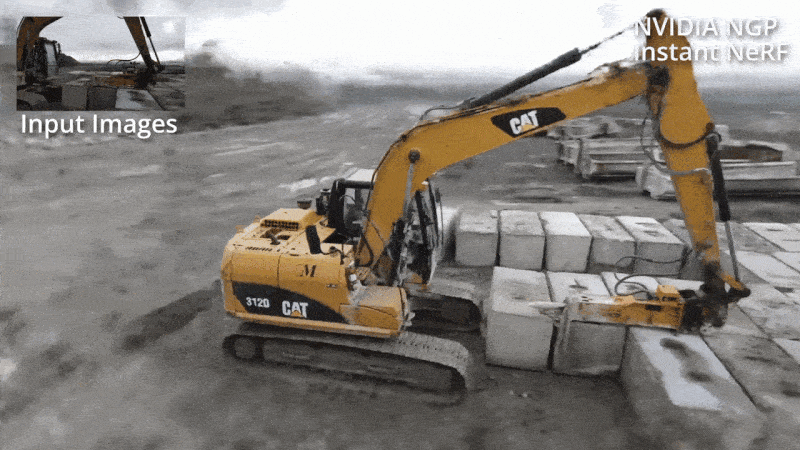NeRF: Transforming Photos into 3D Scenes in Seconds
The NeRF 3D modeling system is a revolutionary approach that combines deep learning and computer vision techniques to generate highly detailed and realistic 3D models of objects and scenes. The system works by using a large set of 2D images taken from different viewpoints of the object or scene. These images are then fed into a neural network that learns to infer the 3D structure and appearance of the object or scene. The result is a high-fidelity 3D model that can be rendered from any viewpoint with astonishing realism.
Imagine capturing a realistic 3D scene from a handful of still images. That's the magic behind NeRF (Neural Radiance Fields). It leverages artificial intelligence to essentially reverse the process of photography, turning 2D photos into a digital 3D world.
How Does it Work?
Think of it as a highly detailed picture painter. Instead of using brushes and paint, it uses a neural network, a powerful computer program that learns from data. Here's the artistic process:
Data Collection: NeRF, like a photographer, needs a collection of images of the scene you want to capture in 3D. These images should be taken from various angles, similar to how you might walk around an object to get a complete picture. Importantly, the camera positions for each image also need to be recorded.
Filling in the Blanks: With its collection of 2D images, NeRF goes to work. It trains the neural network to essentially act like a scene sculptor. The network analyzes the light and color data from the images and learns how light interacts within the 3D space. It then uses this knowledge to predict the color of light radiating from any point in that 3D space. This allows NeRF to reconstruct the entire scene, even accounting for occlusions (when objects are hidden from certain viewpoints in the photos).
The NeRF 3D modeling system is incredibly useful in various fields such as computer graphics, virtual reality, augmented reality, and even in fields like archaeology and cultural heritage preservation. Its ability to accurately capture the intricate details of objects and scenes makes it an invaluable tool for creating realistic virtual environments, digital reconstructions of historical sites, and even for generating lifelike characters and objects in movies and video games. This 3D modeling system's innovative approach has significantly advanced the field of computer vision and deep learning. By leveraging a large set of 2D images from different perspectives, the neural network can accurately learn the intricate 3D structure and appearance of the object or scene. This capability has unlocked a wide array of applications across diverse industries.
Industries impacted
Autonomous cars use this to simulate and navigate real-world environments, allowing them to understand and react to their surroundings with a high level of precision. In the field of virtual reality, NeRF has enabled the creation of immersive, lifelike experiences by generating detailed 3D models that accurately represent the physical world. When applied to cultural heritage preservation, NeRF has been instrumental in digitally preserving and recreating historical artifacts and sites, providing a means to safeguard and share cultural heritage with future generations. The continued development and refinement of NeRF technology hold the promise of even more impactful applications in the future, with the potential to reshape industries and enhance our understanding and interaction with the physical world.
In the realm of computer graphics, NeRF has revolutionized the creation of virtual environments by enabling the generation of highly detailed 3D models with astonishing realism. The system's ability to capture subtle nuances and intricate details has elevated the quality of graphics in virtual reality and augmented reality experiences, providing users with immersive and lifelike digital environments.
In fields such as archaeology and cultural heritage preservation, the NeRF 3D modeling system has played a crucial role in digitally reconstructing historical sites and artifacts with unprecedented accuracy. This has not only facilitated the preservation of cultural heritage but also provided researchers and historians with powerful tools for studying and sharing these valuable resources. Furthermore, in the entertainment industry, NeRF has proven to be an indispensable tool for creating lifelike characters and objects in movies and video games. The system's ability to faithfully render the appearance and structure of objects from any viewpoint has significantly enhanced the visual quality and realism of digital content, offering audiences an unparalleled viewing experience.
The future of 3D capture likely lies in combining the strengths of NeRF and indoor mapping. Imagine using NeRF to add realistic lighting and textures to a highly detailed 3D point cloud generated by LiDAR. This could lead to the creation of incredibly realistic digital twins of indoor spaces, useful for architectural design, real estate visualization, facility management, and even indoor robot navigation.
-by Shikhar Jaiswal and Sameer Sankhe


